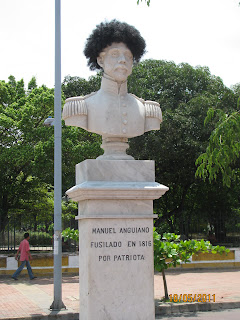Sailing into port, we were surrounded by rows upon rows of luxurious looking apartment blocks along a palm-lined esplanade. The curious thing was that even though the majority were residential towers, very few of them had any lights on, save the occasional penthouse and row of lights marking the lift shafts.
On closer inspection it is apparent that this is money laundering par excellence - the billions of dollars generated from Colombia's rampant cocaine trade had to be cleaned up and spent on something, and real estate must have been one of the better ways to sink the dirty money into worthwhile projects. The only problem is that the apartments are unaffordable for most Colombians, hence the large number of empty floors.
 |
| Pirates shaped the course of Cartagena's history |
Encased between the impenetrable walls is the remarkably well-preserved old town, all beautifully painted stone buildings with bougainvillea overhanging upstairs terraces. Although obviously set up to be a big gringo hangout, it was a surprisingly pleasant place to walk in and around, and we ended up being detained there for a couple of days longer than we had anticipated.
 |
| El Castillo de San Felipe |
Our stay in Cartagena was made more pleasant by the fact that the dorm room in our hostel was pleasantly air-conditioned at night, providing welcome respite from the oppressive heat. It became ultra-muggy on a couple of occasions when it rained in the afternoon. It was quite a well-organised modern hostel, especially compared to Central American standards, but after a couple of days we moved to a hostel that had a pool and a more, shall we say interactive vibe, with a reputation for organising big parties. Both hostels were great places to meet people, and strangely the town seemed to be a mecca for other Australians. We spent much of our time with a fun couple from Canberra who were travelling in South America after living in Whistler for the Canadian ski season.
Cartagena does have a bit of a yuppie vibe to it, and its quickly apparent that this is where wealthy Colombians come to relax and party, but parts of it do have a more authentic feel to it. Some bustling food and trinket markets cut through the centre of the old town, selling all the usual tropical favourites like enormous mangoes and avocadoes, yet more fruits I hadn't heard of (many of which look like oversized passionfruits) as well as the trademark Colombian fried snacks, filled with various meats and cheeses.
Maybe it was the heat, but things in Cartagena moved really slowly. One day we went for lunch, which consisted of a "menu of the day" where you chose between chicken, fish and beef, and get a free bowl of soup thrown in. As soon as we'd commandeered a table at the crowded restaurant, we were completely ignored by the indifferent waitress who shuffled around at a glacial pace.
Without asking us what we wanted to order, she slapped down the bowls of soup, and took about half an hour to bring our drinks over - and only after we'd asked a second time. Our actual meals didn't come for over an hour - fortunately they were good value and tasty - each came with rice, fried bananas, beans and salad and cost less than $5 apiece. Getting the bill was another half-hour long exercise, and the whole experience took us just under two hours, for a comida corriente which ironically means "fast food" in Spanish.
 |
| Curiously, the statues all had afros! |
As soon as we'd left the walls of the quaint old city, it became clear that this part of Cartagena is a stark contrast to the rest of the city, whose population is over 1 million. The taxi weaved is way through dusty potholed streets, avoiding bicycle taxis, rubbish carts and stray dogs, and the concrete housing gradually became shabbier and more ramshackle.
We had no chance to check out the departures list when we arrived at the bus terminal - instead we were herded onto a bus by a hyperactive tout who assured us it was a direct service to Santa Marta, would only take 3.5 hours and would be leaving straight away. It turned out he lied about all three things. The bus did happy laps of the surrounding area until it picked up enough passengers, which took an hour, we had to change halfway to another bus, and the whole trip took about 6 hours door to door.
 |
| At least the cops get around in style! |
To top off the experience (made worse by the fact that we'd had a pretty big party the night before), for the last hour they had turned the TV on in the bus but the reception quickly disappeared, leaving a disturbingly loud static noise ripping apart our eardrums.


No comments:
Post a Comment